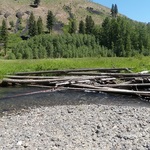
by Dayle Wallien - nationalforests.org – 20-12-2021
On the Idaho-Panhandle National Forest , Okanogan-Wenatchee National Forest and Tongass National Forest Treasured Landscapes, Unforgettable Experiences campaign sites, we have been working with hydrologists, biologists and ecologists to enhance fish habitat by restoring an important in-stream element: wood!
While it may seem counterintuitive, adding large woody material (LWM) , including whole trees, limbed logs and rootwads, to forest streams can provide many benefits to fish.
In an undisturbed forest ecosystem, wood is naturally “recruited” to streams in various ways. Riparian trees growing along the channel fall into the channel when they are undercut by the stream, toppled by beavers, burned by fire or blown down during storms. Upslope trees can be transported into the channel by events such as avalanches or landslides . Flooding can wash trees into the channel and during highwater they may be pushed downstream.
In-stream woody debris has been drastically reduced in some streams by historical forest management practices. Logging near rivers and streams limited the number of trees that could fall into streams. Road building that channeled streams through culverts prevented downstream wood recruitment. “Stream cleaning” was sometimes conducted to remove fallen trees from streams, for beautification, to prevent damage to infrastructure downstream, or in a misguided attempt to assist fish migration.

Scientists have now come to understand that in-stream LWM is ecologically important for a number of reasons:
LWM can help spawning gravels accumulate , by stopping the gravel from moving downstream;
Pools can form behind LWM, which provide important juvenile rearing habitat, as well as habitat for all fish during periods of low-flows;
LWM can help slow stream speed , which helps adult fish as they move upstream and shelters rearing juveniles from using too much energy fighting currents;
LWM provide shade , offering pockets of cooler water, and can help to lower the temperature of an entire stream;
LWM provides fish with refuge from predators ;
LWM can help to stabilize banks, prevent erosion and decrease sediment movement that can harm downstream fish habitat;
LWM is important to the aquatic food chain, because it traps organic matterand provides habitat for insects and invertebrates, which are both food for fish.
All of these elements add “complexity” to a stream. When it comes to fish habitat, complexity is a good thing. And one of the best ways to make a stream complex is to simply add wood.



